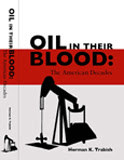Union workers say they're being squeezed out of APS jobs.
Kathy Helms (Dine Bureau/Gallup Independent)
FARMINGTON – A group of Navajo carpenters, laborers and millwrights working at Four Corners Power Plant believe they are being eased out of jobs by contractors hired by Arizona Public Service Co.
Members of the Carpenters Union Local 1319, Labor Local 16, Operating Engineers Local 953, and Millwrights Local 1607 met Monday in Farmington to raise concerns about the purpose of the Navajo Preference in Employment Act and other issues associated with APS bringing in outside contractors.
“We realize that the entire country is in a recession and employment is scarce for all, but is it also necessary to forgo Navajo laws in order to provide for families we don't have any familial obligations to?” asked Leland Gray.
“These corporations are sent here to our land in search of our natural resources in order to provide power and energy to urban areas where we really don't have any cultural ties. Yet, Navajos continue to pay with their land and, now, livelihood to provide for millions who will never know or appreciate the source of their comfort and luxury,” he said.
Damon Gross of APS said there are approximately 150 workers on-site that APS has brought in from contract companies.
Lee Pierce, a carpenter, said he has been at Four Corners off and on for about 30 years. He now works for Day & Zimmermann, the designated contractor, and the nation's leader in power plant maintenance and modifications.
“Navajo Preference has been pretty much deleted, and so far, management service looks the other way. We're slowly being forced out of our position and our work as far as Navajo craftsmen is concerned,” Pierce said.
“Our livelihood depends on this. We've got families here. We buy our goods here, and services, so the money is recirculated in this area while the other contractors, it's pretty much take the money and leave. The businessmen of San Juan County should be concerned also.”
The union members question whether non-union workers are being imported and paid wages below union scale while Navajo union workers are laid off. APS permanent workers are not being laid off, according to Gross, however, that is not to say that APS contractors do not have layoffs from their pool of workers as the rebuild jobs are completed.
Harold Litzin, a carpenter from Tsaile-Wheatfields, has been on the job for more than seven years. Litzin builds scaffolding, he said, but on Monday he watched Safeway Services bring in two rigs of materials and a bunch of workers. “The majority, what I see, is they are Hispanic,” he said.
According to Gross , 30 of the 150 outside contract workers are from Safeway and are non-union.
“Unit 2 at the Four Corners Power Plant is undergoing a planned maintenance outage, so the unit gets shut down while we do the necessary work to keep it operating. As such, that requires bringing in contract work to help complete the job in a safe and expedient manner,” Gross said.
Safeway has been a leader in scaffolding services and access solutions in North America since 1936. In the past, Gross said, the contractor they used installed lumber scaffolding. This year, APS wanted to try something different. Safeway scaffolding “goes together like an erector set. It's safe, it's meant for this usage, and when the work is done it's simply disassembled and then used again,” he said.
Instead of lumber being put together, then taken down, and APS having to find a purpose for that lumber, Gross said they thought the Safeway system “presented an opportunity to make the workplace even safer for those there, but we also believe it will help complete the work faster, and there's no wasted materials.”
Part of APS' commitment to Four Corners is hiring members of the Navajo Nation and giving them preference for jobs at the plant site, according to Gross. “About 73 percent of our full-time employees are from the Navajo Nation,” he said. However, if APS hires a contractor and they bring in their own permanent employees, Navajo Preference is not stipulated.
“That is the case with Safeway. These are their own permanent employees. These aren't supplemental contract workers that they're bringing in. If a company has their own employees already in place, we can't stipulate that they have to replace those employees for this one very small job,” he said.
Gross said all of Safeway's Hispanic workers have Social Security numbers, their Green Cards have been verified, and they are on the job legally.
Stanley Tso, a laborer with Local 16, said D&Z employees are drug-tested at random and questioned whether other outside contractors follow the same standards. Tso said he recently smelled alcohol in the work area. “When we have a case like that, a family member has to be called to drive them home.”
Tso and Felipe Dawes of Operating Engineers Local 953 questioned whether outside workers have the same certifications they as union workers are required to have. “I've got rigging cards. In order to rig, we're supposed to have rigging cards. Even driving a man-lift around, we're supposed to have cards for that,” Tso said.
Dawes, a union member for 37 years, agreed. “I see a lot of equipment being operated by non-union people. I don't know whether they have certifications or not. When I run my crane or forklift or whatever, I'm certified. On Unit 4, I was running an overhead crane. We were certified through APS to run that overhead crane.
“But outside, like the forklift and the hydraulic cranes, it's different. You can hurt someone very seriously without thinking about it, like by lifting materials up into the units and going around the units. It's posted 5 miles per hour. Some of them don't obey. They just take off like a bat out of hell.”
The union workers want to see Navajo tribal officials need to take more of an interest in what's going on at Four Corners. “We need backup,” Pierce said. “We expect them to step up to the plate, but it's not happening.”
Gray said he is concerned for his fellow workers. “APS is their bread and butter. They've been working there for 10 or 15 years, and then all the sudden, these guys come in, and they're just taking food off their table. Navajo people are losing their jobs on their own land. I just don't agree with that.”
Jerry Huskay said, “We love what we do at Arizona Public Service. We just don't understand why we are being replaced by non-Navajos and non-union workers. Maybe the managers at corporate should look and see how these new contractors are working and check to see if they are doing it safely.”






 Plug-in Hybrids, The Cars That Will Recharge America
Plug-in Hybrids, The Cars That Will Recharge America Oil On The Brain
Oil On The Brain





